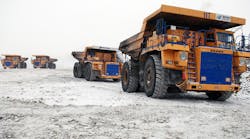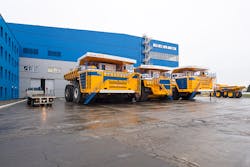According to a PwC mining report, the overall market capitalization of the mining industry reached $926 bn in 2018, rising 30% on the back of a commodity price recovery. Some, however, regard this price recovery as temporary, while noting that employee costs increased by 5%. The European Union has announced that it is keenly interested in developing autonomous mining technology as part of its drive towards robotics under its Horizon 2020 work programme. It believes that autonomous machines can generate an improvement potential of 40%-80%. In other words, the promotion of automation in mining is going to continue. And it was the industrial vehicles employed in ore mines and pits that were first to encounter this automation.
AI and IoT-driven progress
Mining automation first emerged in the form of self-driving vehicles. These monstrous trucks, which use AI and IoT technologies, can operate 24/7 with no need for driver breaks or shift changes.
AI for industrial vehicles is a step into the future. It is a technology that can greatly improve the performance of autonomous vehicles, as it relies on a mathematical model and previous human-learned information.
Mining automation and connected mining projects prove that the Internet of Things is already a reality which is already generating massive savings in the industries that have embraced it. Wireless mesh networks are the most common technology used to connect mining trucks to each other in areas where there is no cellular or WiFi coverage. IoT for industrial vehicles can be used to monitor people, vehicles, and machines both inside an ore mine or in a pit. IoT also ensures safety: small devices can monitor the locations of workers and can also be used as remote emergency buttons.
In contrast to driverless cars, industrial self-driving vehicles have been in common use in mining facilities for almost 5 years. Although both are using the same technology, the environment is completely different: most obviously, the absence of unexpected traffic or additional people on the ground, and a lack of uncertainty.
Perhaps the most vivid example of this new technology in action is Rio Tinto’s Pilbara iron ore mine, where one can find 80 driverless Komatsu trucks. Using GPS, radar and laser sensors, the trucks can make their way around the mine site avoiding obstacles and delivering high-grade ore to be processed. In 2017, the Pilbara project announced that its trucks had moved 1 bn tonnes of material while cutting unit costs at the mine by 15%.
Intelligent monsters
The CAT 797, originally designed in 1998, seems to be the most recognizable dump truck ever developed. Made by Caterpillar, it has been reincarnated multiple times, most recently in 2009 when the Cat 797F was launched. This model is the second-biggest dump truck in the world, with a payload of 400 t. In mid-2018, Caterpillar announced that it had 150 automated trucks operating all over the globe.
Somewhat later, in October 2018, another “monster” got “smart”. The world’s biggest dump truck, the Belaz 75710, weighs in at an incredible 496 t. It was developed in 2013 by Belaz, a mining manufacturing company based in Belarus, and went on sale in 2014. Measuring 20.6 m in length, 8.16 m in height and 9.87 m across, the house-sized truck was the first to be able to transport more than 450 t. In late October, Belaz brought out an industrial loading and transport system for the mining industry, comprising a fully autonomous Belaz truck and a self-driving BelAZ-78250 front loader working in unison. This year, the new system will start operating in Morocco.
Challenges of today
Fully autonomous, remotely controlled and regular vehicles now coexist on the ground. For instance, the Belaz truck is a fully self-driving vehicle, and the Belaz loader drives itself, while loading and unloading operations are controlled by a human operator from a comfortable chair in a remote control room.
Leading equipment manufacturers Komatsu, Caterpillar, and Hitachi have had notable success in rolling out autonomous haulage systems, with economic and safety benefits identified as the primary drivers, as well as productivity increases of up to 30% in some operations.
Nevertheless, the situation is far from ideal. The biggest challenge is the lack of standards for industrial vehicle automation. The big manufacturing companies are all at the stage of integrating their solutions into existing processes.
Moreover, the industrial vehicle is a huge truck that operates in a harsh environment, with safety figuring alongside profitability at the top of the criteria list. The most demanding areas of application are very high and very low-temperature environments, such as coal mines or underground ore pits.
Future prospects
Industrial vehicle automation is a core component of the building industry 4.0 because it features most of the so-called next-gen industry pointers such as Big Data analytics, additive manufacturing, robotics, high-performance computing, artificial intelligence, and cognitive technologies.
It is anticipated that 5 years from now, most mining vehicles will be “smart” and industrial machines - loaders, excavators, bulldozers, drills, and many others - will be automated. Robots of various kinds will be used to monitor mining operations and ensure that everything is running according to plan. Some of them will move through underground mines. With their laser scanners and radar, they will be able to travel safely and quickly in narrow, dusty tunnels that humans have trouble navigating.
It is now vital to ensure that this process of automation develops on the basis of both economic and humanistic incentives.











